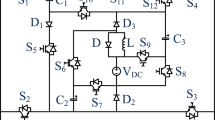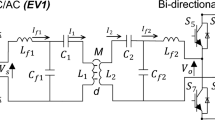Abstract
This paper proposes a novel capacitive power transfer (CPT) system with switchable compensation for achieving constant current (CC) or constant voltage (CV) output against load and coupling capacitance variations. Meanwhile, a parameter design method is proposed to ensure a low input impedance angle at constant operation modes. Mathematical models of voltage and current gains are established, which are used to analyze the CC and CV operation modes of the proposed CPT system. Two relays are adopted in receiver to reconfigure the compensation network to switch the CC mode and CV mode. The communication between the transmitter and receiver is not needed, and complex control is not required either for changing two operation modes. An experimental setup with 2A output current in CC mode and 96 V output voltage in CV mode is constructed. Experimental results show that the maximum variation of the output current is 4.0% in CC mode, and the maximum variation of the output voltage is 5.0% in CV mode, when the load resistance and coupling capacitance vary from 24 to 72 ohms, and 500 to 1000 pF, respectively. Experimental results verify the CC/CV output and the effectiveness of the proposed parameter design method.
















Similar content being viewed by others
References
Zou LJ, Zhu Q, Neste CWV, Hu AP (2019) Modelling single-wire capacitive power transfer system with strong coupling to ground. IEEE J Emerg Select Top Power Electron
Zhou W, Zhu Z, Mai R et al (2020) Design and analysis of decoupled tetra-polar ring-coils for wireless power transfer in rotary mechanism applications. IET Electr Power Appl 14(10):1766–1773
Choi BH, Nguyen DT, Yoo SJ et al (2014) A novel source-side monitored capacitive power transfer system for contactless mobile charger using class-E converter. In: 2014 IEEE 79th vehicular technology conference (VTC Spring), Seoul, pp 1–5
Sedehi R, Budgett D, Jiang J et al (2021) A wireless power method for deeply implanted biomedical devices via capacitively-coupled conductive power transfer. IEEE Trans Power Electron 36(2):1870–1882
Dai J, Ludois DC (2016) Capacitive power transfer through a conformal bumper for electric vehicle charging. IEEE J Emerg Select Top Power Electron 4(3):1015–1025
Mou X, Gladwin DT, Zhao R et al (2019) Survey on magnetic resonant coupling wireless power transfer technology for electric vehicle charging. IET Power Electron 12(12):3005–3020
Zhang H, Lu F (2020) Insulated coupler structure design for the long-distance freshwater capacitive power transfer. IEEE Trans Ind Inf 16(8):5191–5201
Li Y, Hu J, Liu M et al (2019) Reconfigurable intermediate resonant circuit based WPT system with load-independent constant output current and voltage for charging battery. IEEE Trans Power Electron 34(3):1988–1992
Su Y, Xie S, Wang Z et al (2019) An electric-field coupled power transfer system with constant voltage and constant current output based on F-F/T changeable resonant circuit. Diangong Jishu Xuebao/Trans China Electrotechn Soc 34(6):1127–1136
Qu X, Han H, Wong S et al (2015) Hybrid IPT topologies with constant current or constant voltage output for battery charging applications. IEEE Trans Power Electron 30(11):6329–6337
Vu V, Kamal LBM, Tay, J.,: ‘A multi-output capacitive charger for electric vehicles’, et al (2017) IEEE 26th international symposium on industrial electronics (ISIE). Edinburgh 2017:565–569
Abramov E, Peretz MM (2020) Multi-loop control for power transfer regulation in capacitive wireless systems by means of variable matching networks. IEEE J Emerg Select Top Power Electron 8(3):2095–2110
Zang S, Lu K, Nguang SK et al (2019) Robust H∞ output feedback control of a rotary capacitive power transfer system. IEEE Access 7:113452–113462
Kim S, Covic GA, Boys JT (2017) Tripolar pad for inductive power transfer systems for EV charging. 32(7):5045–5057
Zhao L, Thrimawithana DJ, Madawala UK et al (2019) A misalignment-tolerant series-hybrid wireless EV charging system with integrated magnetics. IEEE Trans Power Electron 34(2):1276–1285
Su Y, Xie S, Hu AP et al (2017) Capacitive power transfer system with a mixed-resonant topology for constant-current multiple-pickup applications. IEEE Trans Power Electron 32(11):8778–8786
Chen X, Wu H, Mu X et al (2015) The current-type capacitively coupled wireless power transfer technology. Zhongguo Dianji Gongcheng Xuebao/Proc Chin Soc Electr Eng 35(9):2279–2286
Lu F, Zhang H, Hofmann H et al (2018) A double-sided LC-compensated circuit for loosely-coupled capacitive power transfer. IEEE Trans Power Electron 33(2):1633–1643
Qing X, Wang Z, Su Y et al (2020) Parameter design method with constant output voltage characteristic for bilateral LC-compensated CPT system. IEEE J Emerg Select Top Power Electron 8(3):2707–2715
Abramov E, Alonso JM, Peretz MM (2019) Analysis and behavioural modelling of matching networks for resonant-operating capacitive wireless power transfe. IET Power Electron 12(10):2615–2625
Liu S, Li X, Yang L (2019) Three-coil structure-based WPT system design for electric bike CC and CV charging without communication. IET Electr Power Appl 13(9):1318–1327
Li L, Wang Z, Gao F et al (2020) A family of compensation topologies for capacitive power transfer converters for wireless electric vehicle charger. Appl Energy 260:114156
Acknowledgements
Authors of this paper gratefully acknowledge the support of China National Center for International Research on Wireless Power Transfer Technology.
Author information
Authors and Affiliations
Corresponding author
Additional information
Publisher's Note
Springer Nature remains neutral with regard to jurisdictional claims in published maps and institutional affiliations.
Rights and permissions
About this article
Cite this article
Qing, X., Su, Y., Hu, A.P. et al. A CPT system with switchable compensation for constant current or voltage output against load and coupling capacitance variations. Electr Eng 103, 2391–2402 (2021). https://doi.org/10.1007/s00202-021-01235-3
Received:
Accepted:
Published:
Issue Date:
DOI: https://doi.org/10.1007/s00202-021-01235-3




